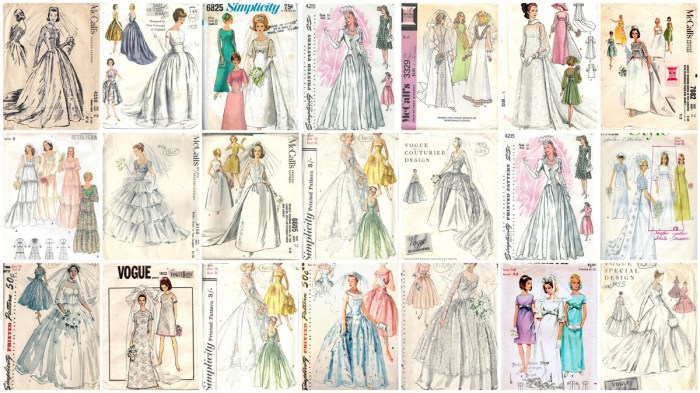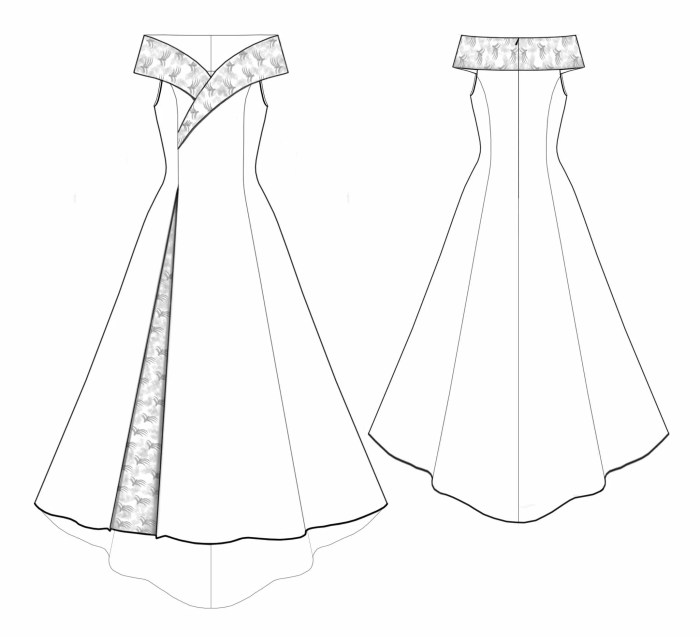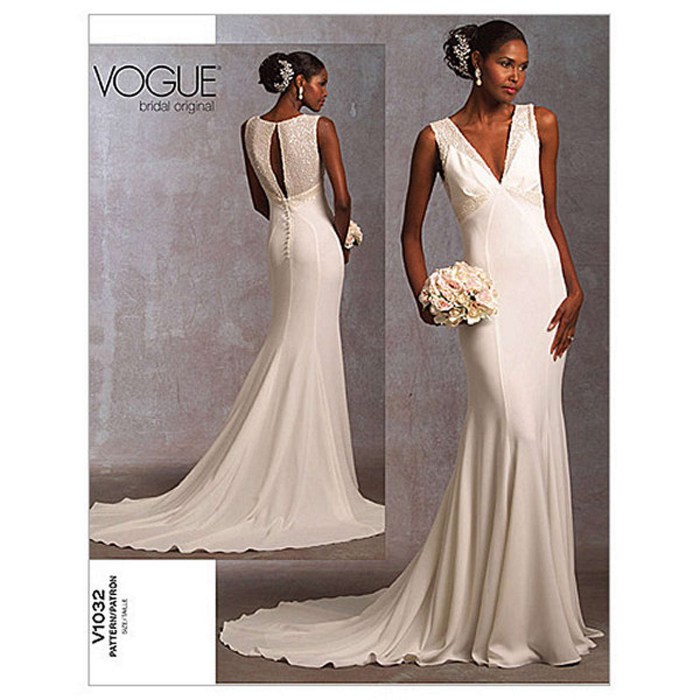Defining “Simplicity” in Wedding Dress Patterns
Simplicity wedding dress patterns – The term “simple” in wedding dress design is surprisingly multifaceted. It transcends a mere absence of embellishment, encompassing a spectrum of aesthetics, each with its own unique appeal. Understanding these nuances is crucial for both designers and brides seeking a refined, elegant, and effortlessly stylish gown.
Interpretations of Simplicity in Wedding Dress Design
Three distinct interpretations of “simple” emerge within the context of wedding dress design: minimalist, understated, and classic. Each approach prioritizes different aspects of design, resulting in diverse yet equally captivating silhouettes.
Design Elements Contributing to a Simple Aesthetic
Several design elements contribute to a simple aesthetic, emphasizing clean lines and uncluttered forms. The focus remains on the inherent beauty of the silhouette and fabric.
- Clean lines and silhouettes
- Minimal embellishments or detailing
- High-quality, flowing fabrics
- Simple necklines (e.g., V-neck, scoop neck, bateau)
- Unfussy sleeves (e.g., sleeveless, simple cap sleeves, long sleeves)
Comparison of Minimalist, Understated, and Classic Simple Wedding Dress Styles
The table below contrasts minimalist, understated, and classic simple wedding dress styles, highlighting their key differences in silhouette, fabric choice, and detailing.
| Style | Silhouette | Fabric | Detailing |
|---|---|---|---|
| Minimalist | A-line, sheath, column | Silk crepe, crepe georgette, matte jersey | No embellishments, clean lines |
| Understated | Fit-and-flare, empire waist | Lace, chiffon, silk charmeuse | Subtle lace accents, delicate beading |
| Classic Simple | A-line, ballgown (simplified) | Silk satin, organza, taffeta | Simple embroidery, subtle pleating |
Popular Simplicity Wedding Dress Pattern Styles: Simplicity Wedding Dress Patterns

Source: tomandlorenzo.com
Several simple wedding dress styles consistently remain popular due to their timeless elegance and versatility. These styles cater to a range of preferences and body types.
Prevalent Simple Wedding Dress Styles and Their Characteristics
Five prevalent styles of simple wedding dresses, each with unique characteristics, dominate current trends.
- A-line: A universally flattering silhouette, characterized by a fitted bodice that gradually flares out from the waist, creating a graceful, flowing shape.
- Sheath: A sleek, form-fitting silhouette that hugs the body from shoulders to hem, ideal for showcasing a confident and elegant figure.
- Fit-and-flare: A combination of a fitted bodice and a flared skirt, offering a balance between form-fitting and flowing aesthetics.
- Empire waist: A style defined by a high waistline that sits just below the bust, creating a long, flowing skirt that is both comfortable and flattering.
- Column: A long, straight silhouette that falls vertically from the shoulders to the floor, exuding sophistication and simplicity.
Historical Influences on Simple Wedding Dress Designs

Source: lekala.co
Several historical periods have significantly influenced current simple wedding dress designs.
- 1920s Flapper Dresses: The relaxed, drop-waist silhouette and use of flowing fabrics influenced modern minimalist and understated designs.
- 1930s Bias-Cut Gowns: The fluid lines and flattering drape of bias-cut gowns continue to inspire modern simple wedding dresses.
- 1960s Minimalism: The clean lines and unadorned elegance of 1960s fashion have had a lasting impact on contemporary minimalist wedding dress styles.
Suitability of Simple Wedding Dress Styles for Different Body Types and Venues
The suitability of each style varies depending on body type and venue.
A-line:
- Body Types: Flattering on most body types.
- Venues: Suitable for various venues, from formal churches to beach weddings.
Sheath:
- Body Types: Best suited for slender figures.
- Venues: Ideal for formal settings like city halls or upscale restaurants.
Fit-and-flare:
- Body Types: Flattering on most body types, particularly those with a defined waist.
- Venues: Versatile and suitable for a range of venues.
Empire waist:
- Body Types: Very flattering for pregnant brides or those who want to emphasize their bust.
- Venues: Works well for both casual and formal settings.
Column:
- Body Types: Best suited for slender figures.
- Venues: Ideal for modern, minimalist settings.
Fabric Choices for Simple Wedding Dresses
Fabric selection significantly impacts the drape, texture, and overall aesthetic of a simple wedding dress. Choosing the right fabric is crucial for achieving the desired look and feel.
Properties of Suitable Fabrics for Simple Wedding Dresses
The following table details the properties of five suitable fabrics for simple wedding dresses, considering drape, texture, ease of sewing, and potential drawbacks.
| Fabric | Properties | Suitability for Simple Styles | Potential Drawbacks |
|---|---|---|---|
| Silk Crepe | Drapey, matte finish, luxurious feel | Minimalist, understated | Can be expensive, requires careful handling |
| Crepe Georgette | Lightweight, slightly sheer, delicate drape | Understated, romantic | Can be fragile, needs delicate handling |
| Silk Charmeuse | Smooth, lustrous, luxurious drape | Classic simple, understated | Can be slippery to sew, requires careful pressing |
| Cotton Poplin | Crisp, opaque, easy to sew | Classic simple | Less drape than silk, can wrinkle easily |
| Linen | Durable, breathable, natural texture | Classic simple, rustic | Can wrinkle easily, requires careful pressing |
Simple Wedding Dress Pattern Using Two Contrasting Fabrics
A simple A-line wedding dress could be designed using silk crepe for the bodice and cotton poplin for the skirt. The silk crepe provides a luxurious, smooth drape for the fitted bodice, while the cotton poplin offers a crisp, structured counterpoint for the skirt, creating visual interest and textural contrast.
Comparison of Natural and Synthetic Fabrics, Simplicity wedding dress patterns
Natural fabrics like silk and linen offer luxurious drape, breathability, and a unique texture. However, they can be more expensive and require more careful handling. Synthetic fabrics like polyester offer affordability and durability but may lack the luxurious feel and breathability of natural fibers.
Essential Patternmaking Techniques for Simplicity
Creating a simple wedding dress pattern requires a grasp of fundamental patternmaking techniques. Mastering these techniques allows for customization and achieving a perfect fit.
Fundamental Patternmaking Techniques
The following steps Artikel the process of drafting a basic bodice and skirt pattern.
- Take accurate body measurements: Bust, waist, hip, shoulder width, back width, and desired dress length.
- Draft a basic bodice block: Using standard patternmaking methods, create a sloper or basic bodice pattern based on your measurements.
- Draft a basic skirt pattern: Choose a skirt style (A-line, circle, etc.) and draft the pattern based on your waist and desired length.
- Combine bodice and skirt patterns: Match the waistline of the bodice and skirt patterns.
- Create a muslin mock-up: Sew a test garment from inexpensive fabric to check the fit and make necessary adjustments.
- Refine the pattern: Make adjustments based on the muslin mock-up, ensuring a perfect fit.
Adjusting a Basic Pattern for Different Body Measurements
Adjustments for bust, waist, and hip measurements are crucial for a well-fitting dress. Specific adjustments will vary depending on the pattern and body type but generally involve adding or removing fabric at the seams.
Adding Subtle Details to Simple Designs

Source: theboiledpeanuts.com
Subtle details can elevate a simple wedding dress without detracting from its minimalist aesthetic. These carefully chosen elements add personality and sophistication.
Subtle Details to Enhance Simple Wedding Dresses
- Delicate lace trim at the neckline or hem
- Subtle beading or embroidery
- A unique back detail (e.g., keyhole, low back)
- A subtle belt to define the waist
- Hand-stitched button closure
Neckline Variations for Simple Wedding Dresses
Three neckline variations significantly impact the overall look of a simple wedding dress.
- V-neck: Elongates the torso, creates a flattering look on most body types.
- Scoop neck: Classic and versatile, suits a variety of necklines and body types.
- High neck: Elegant and sophisticated, can be paired with long or sleeveless styles.
Organization of Design Elements by Increasing Complexity
For a simple wedding dress, the design elements should be organized in order of increasing complexity: neckline, sleeves, embellishments.
Illustrative Examples of Simple Wedding Dress Patterns
Several simple wedding dress patterns showcase the versatility and elegance of minimalist design.
A-line Wedding Dress Pattern
This A-line wedding dress features a simple scoop neckline, sleeveless design, and is crafted from a lightweight silk crepe. The silhouette flows gracefully from a fitted bodice to a gently flared skirt, creating an effortlessly elegant look. The waist is subtly defined by a self-fabric sash. Measurements would be based on standard A-line patternmaking, with adjustments made for individual body measurements.
Construction involves sewing the bodice and skirt separately and then joining them at the waist.
Sheath Wedding Dress Pattern
A simple sheath wedding dress, constructed from crepe georgette, features a bateau neckline and long sleeves. The sleek silhouette hugs the body, creating a sophisticated and refined look. Minimal embellishments, perhaps a single row of delicate buttons down the back, add a touch of understated elegance. The pattern would be based on a standard sheath dress pattern, with careful attention paid to ensuring a precise fit.
Fit-and-Flare Wedding Dress Pattern
This fit-and-flare wedding dress is crafted from a crisp cotton poplin. The fitted bodice, accentuated by a defined waistline, transitions into a gently flared skirt. A simple V-neckline and cap sleeves complete the design. The pattern would involve creating separate bodice and skirt patterns, carefully matching them at the waistline. The crispness of the cotton poplin adds structure and shape.
Top FAQs
Can I use Simplicity patterns for plus-size wedding dresses?
Many Simplicity patterns offer sizing options to accommodate a range of body types, including plus sizes. However, you may need to make adjustments based on your specific measurements.
What is the average cost of Simplicity wedding dress patterns?
The cost varies depending on the pattern’s complexity and retailer. Generally, you can expect to pay between $10 and $30.
Where can I find Simplicity wedding dress patterns?
Simplicity patterns are widely available online through major retailers like Amazon and Joann Fabrics, as well as at local fabric stores.
Are Simplicity patterns easy to follow for beginners?
Simplicity in wedding dress patterns often translates to elegance and understated sophistication. This focus on clean lines and minimal embellishments can also inspire choices for wedding guests, leading many to consider the sleek and stylish options available, such as those found when browsing sheath dresses for wedding guest. Returning to the bridal perspective, the same principle of simplicity ensures the bride’s beauty shines through without distraction, making a minimalist approach a timeless choice.
Simplicity patterns generally provide clear instructions and diagrams, making them accessible to beginners. However, experience with basic sewing techniques is recommended.
